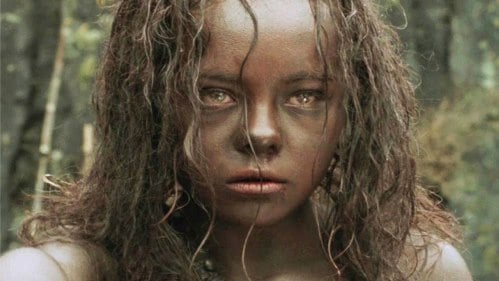
A feral child is a human who has lived away from human contact from a very young age and has little or no experience of human care, loving or social behavior, and, crucially, human language. Feral children are confined by humans (often parents), raised by animals (often wolves), or somehow survived on their own in the wild.
Best-known story of feral children
The best-known story of feral children is that of the two girls, Amala and Kamala, who were raised by a she-wolf.
In 1920 reverend J. A. L. Singh saw a mother wolf and cubs, two of which had long, matted hair and looked human. After considerable preparation and difficulties, the two human creatures were captured. They turned out to be two girls whose ages were assessed by Singh at about eight years and one and a half years, respectively.
The creatures were taken to an orphanage in Midnapore, India, where the Reverend and his wife were stationed. Singh described them as “wolfish” in appearance and behavior. They walked on all fours and had calluses on their knees and palms from doing so.
Acting like wolves
They were fond of raw meat and stole it when the occasion presented itself. They licked all liquids with their tongues and ate their food in a crouched position. Their tongues permanently hung out of their thick, red lips, and they panted just like wolves.
They never slept after midnight and prowled and howled at night. They could move very fast, just like squirrels, and it was difficult to overtake them. They shunned human society altogether. If approached, they made faces and sometimes bared their teeth.
Their hearing was very acute, and they could smell meat at a great distance. Furthermore, while they could not see well during the day, they could orientate themselves very well at night.
In September 1921, both girls became ill, and Amala, the younger, died.
Other feral children
There are many other stories of feral children in the literature, among others, the story of a boy who lived in Syria who ate grass and could leap like an antelope. Another feral child is a girl who lived in the forests in Indonesia for six years after falling into a river. She walked like an ape, and her teeth were as sharp as a razor.
Watch this video of 22 children who were raised by animals:
.
What we learn from feral children
These stories do far more than just confirm the importance of education. They show that a human being can and must be educated to become a human being.
A bear does not have to learn to be a bear; it simply is one. A duck needs no lessons in duckmanship. And an ant leads a perfectly satisfactory life without any instruction from other ants. Even when isolated from birth, animals usually retain recognizable instincts. A cat raised among dogs will still behave like a cat. It won’t try to bite the postman. There are a few exceptions, such as the lion cub, that would be unable to hunt the wildebeest when raised in isolation.
Man, however, enters this world very poorly equipped. The knowledge a child needs to become fully human is not dormant. Everything the child eventually knows or can do must be learned. This excludes natural body functions, such as breathing and reflexes, for example, the involuntary closing of the eye when an object approaches it. Everything else, however, must be learned.
.
Edublox offers cognitive training and live online tutoring to students with dyslexia, dysgraphia, dyscalculia, and other learning disabilities. Our students are in the United States, Canada, Australia, and elsewhere. Book a free consultation to discuss your child’s learning needs.

